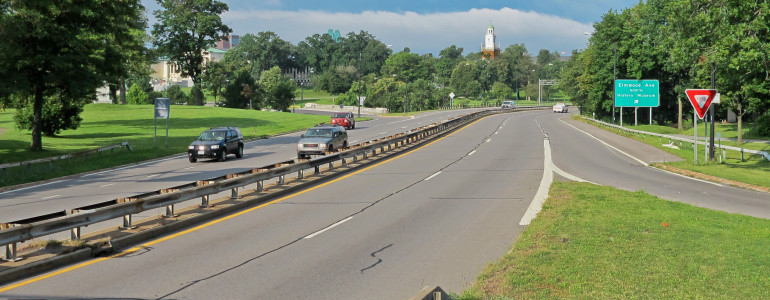“Now is the Time to Demand the Downgrading of Buffalo’s Expressways”

Below article/image was featured in Buffalo Rising, and posted by Mike Puma, August 2, 2013.
“Now is the Time to Demand the Downgrading of Buffalo’s Expressways
This post (everything after this paragraph) was written by Bradley Bethel Jr. who is active in many east side organizations and movements including the Restoring Our Community Coalition, which is working with the NYSDOT for capping a portion of the Kensington Expressway and restoring a part of Olmsted’s vision for the east side with Humboldt Parkway.”
“The entry image in the post was taken this morning at 8:30 from the pedestrian bridge where Lincoln Parkway was severed into two separate streets by the expressway. I stood there for at least 15 minutes and the volume of traffic you see in this image was consistently next to nothing. As Steel aptly pointed out in his recent article, rush hour, our city grid is capable of absorbing this traffic with only a few extra minutes tacked on for suburban commuters. It’s time to rethink our expressway system beginning with the Scajaquada and moving on to the Kensington. Downgrading or completely removing these eyesores that tear communities apart is a once in a generation opportunity. Imagine filling the Kensington Expressway, restoring Humboldt Parkway, and utilizing the below grade portion for a new light rail line from downtown directly to the airport, it’s a conversation worth having. Our last generation left us with a monster that divided neighborhoods, destroyed Buffalo’s grandest parkway, and has caused serious health concerns in adjacent neighborhoods. It’s the responsibility of this generation of Buffalonians to stand up and fight for this so that we can leave a better legacy for our city for future generations to enjoy. Now I’ll leave you to enjoy Brad’s post!
There is an ongoing rivalry between urban planning and suburban planning for Buffalo’s future. Urban planning favors sustainable, accessible neighborhoods that can accommodate both pedestrians and motorists. Suburban planning, known as “sprawl”, favors vast communities where the automobile comes first. These approaches have dueled on many current efforts to improve transportation in and around the city.
One example is the downgrade proposal for the Scajaquada Expressway Route 198 (NYSDOT Project No. 5470.22). The Scajaquada Expressway was implemented in anticipation for motor increase, ironically during a time of mass decline in the region’s population. In relation to Delaware Park, daily noise pollution and limited accessibility have both been unwelcome frustrations to an historic setting meant for tranquility. As we have seen with such sprawl-based planning, it has compromised Buffalo’s heritage in such a way that still has yet to be remedied.
Among four downgrading alternatives up for public discussion, one includes reducing Scajaquada’s speed limit from 50 mph to 40 mph. It is the only alternative that has been pressed by the New York State Department of Transportation for a small number of stakeholders. A somewhat apathetic solution to the intrusion of the existing Route 198, it does symbolize the DOT’s own attitude towards the city and its residents.
I am not against the automobile. I am a driver myself out of necessity, and as you can tell, none of the Scajaquada proposals are going to banish cars completely from Delaware Park. However, there is a growing awareness of the damaging effects that sprawl-based planning has had on local economics.
The motorist spends, on annual renewals in car inspection, registration, and insurance, as well as annual repairs and maintenance an untold average of thousands each year. Buffalo’s gas prices are consistently above the national average, and as of this writing, prices are once again inching towards the $4.00 mark. As downtown development progresses, and with a tough economy in mind, residents of newly-built apartments are discovering the benefits of a long-ignored alternative. In the roughly third of Buffalo residents living without a car, a growing portion are doing so by choice.
In some ways, Buffalo has already begun to embrace the call for multi-modal transportation. The city is moving forward with a plan to make more “complete” streets; streets where motorists, pedestrians, and bicyclers can travel in harmony. Streetscaping on main thoroughfares have included lanes and labels reserved for bicycle traffic. Continued developments in the Medical Campus and the waterfront, as well as increased bus and rail ridership have prompted the NFTA to reopen discussions about expanding the Metro rail.
Imagine another Scajaquada Downgrade alternative. Scajaquada would no longer be an expressway, because traffic would be reduced to 30 mph. But motorists can still travel to key areas of the city on a boulevard that pays respect to its Olmstedian surroundings. It would also open the door for more pedestrian safety and accessibility throughout the park.
The DOT however, appears reluctant to acknowledge the calls for change, evidenced by how the Scajaquada Downgrade has been on and off the shelf for the past 20 years. Their negligence is leaving the general public in the dark on a 2014 deadline before a proposal is finalized. Moreover, it puts Buffalo at risk of once again falling behind the rest of the nation, at the very time when the city is finally proving to be capable of grand accomplishments.”
To download a .pdf of this article, click here.
